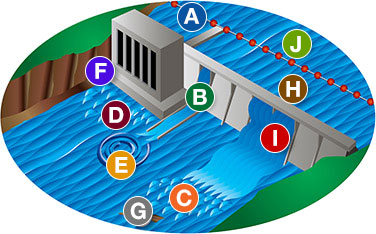Every year, people are seriously injured or killed at dams. Most of these accidents could be avoided by simply staying clear of the restricted zones at dams, by understanding the dangers dams can create, and by obeying all warning devices.
Important tips to stay safe
- Always stay a safe distance outside of warning signs, buoys and barriers when fishing, boating or swimming.
- Stay away from the edge of waters above and below hydroelectric stations.
- Be sure to obey all warning signs and signals.
- Stay back from dry riverbeds below dams. They can quickly change into rapidly flowing waterways.
Be alert for the warning signs of rising water:
- Flashing lights, horns, or sirens.
- Increased or changed wildlife activity.
- Louder sound of rushing water.
- Previously exposed rocks or snags are covered with water.
- Clear water quickly becomes cloudy.
- Suddenly faster water currents.
Critical danger zones at dams

- Hazard area marked by buoy lines
- Sudden water discharge from dam gates
- Strong, unpredictable currents above and below dams
- Sudden turbulent discharges from automatically operated power house generators
- Deceiving reverse currents below spillways
- Slippery surfaces on dam structures and shorelines
- Submerged hazards above and below dams
- Open spillways which may not be visible from above the dam
- Debris passing over or through the dam
- Ice that forms near a dam is often thin and unsafe
Don't take chances when boating or canoeing
- Never anchor a boat below a dam. Rapid surges in water levels can pull an anchored boat under water in seconds.
- Beware of dangerous and unseen currents. Backrollers, eddys, and whirlpools can pull a boat upstream into a spillway and quickly capsize it.
- Boating above or below a dam can be very dangerous. Always maintain a safe distance from the dam. Keep your motor running when near a dam so that you are always ready to maneuver or leave the area quickly.
- Stay away from spillways. Changing currents and unpredictable waves make boat control difficult.
Safe whitewater paddling tips
- Always wear a personal floatation device (PFD).
- According to the American Canoe Association, PFDs were not worn in 48% of kayak fatalities.
- Experienced paddlers are four times more likely to wear their PFD.
- PFDs not only provide additional floatation in case of capsize or unexpected swim, they also provide an essential layer of warmth in cold water.
- It's the law. Federal and state laws dictate when PFD use is necessary.
- Know the hazards.
- Paddling hazards can include rocks, strainers, heavy current, lightning and other bad weather.
Always scout ahead to identify potential hazards and portage around them if necessary.
- Never paddle alone.
- Be in command.
- Know how to stop your craft and move forward, back and sideways using paddle strokes.
- Make sure you know how to right and reenter your craft in the event of capsize.
- Never paddle under the influence.
- Plan ahead.
- There is limited cell-phone reception at Grandfather Falls dam.
- Know the location of nearest medical facility.
- Check local weather information.
- Check flow levels on our website.